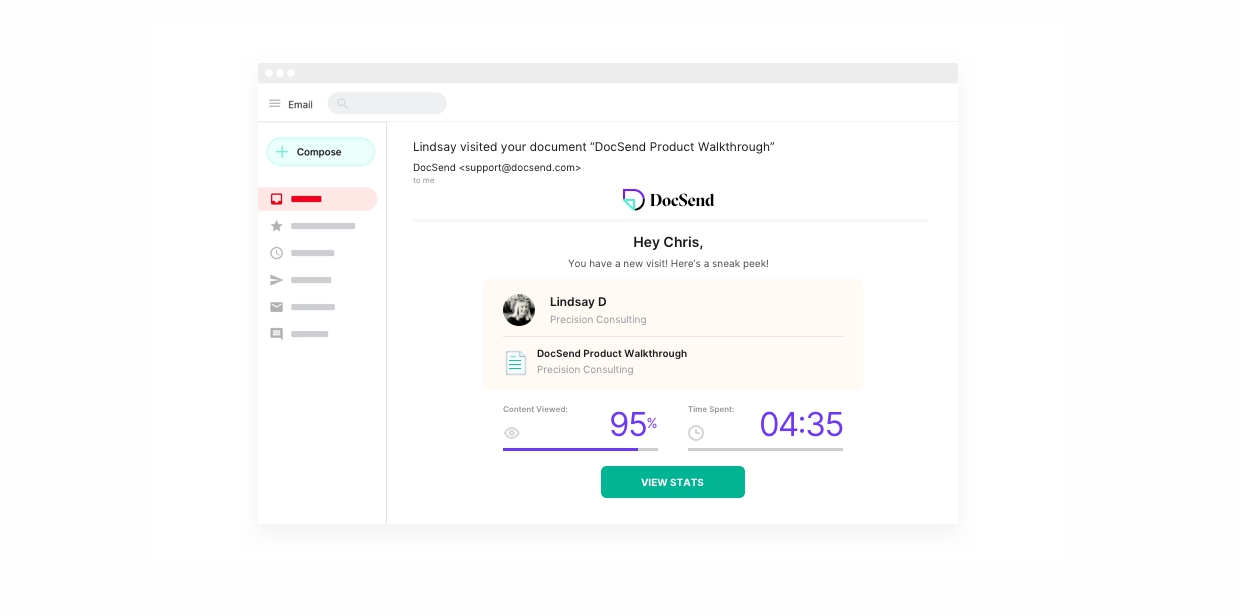In today’s digital world, it’s essential to have the right tools to support document sharing in your business. Whether you’re looking to facilitate employee collaboration or you want to provide a smooth e-signature process to reduce paper usage, both DocSend and Docusign can help.
These popular tools are suitable for many different businesses, but which one is right for your business? Understanding the differences between the tools can help you choose the best option for your needs.
While DocSend and Docusign share a few key similarities, there are some important differences in their capabilities.
DocSend
DocSend (by Dropbox) is a secure document-sharing platform that simplifies the process of managing, sharing, and tracking files. Rather than sending documents as email attachments, you can easily send multiple DocSend links in just seconds for a seamless user experience. DocSend offers link-sharing security options, including the ability to set a passcode and restrict access to certain people to protect your secure files. You can also set expiration dates for the links and control whether recipients can download the files.
DocSend’s e-signature capability is also convenient. You can convert files to signable documents or create them directly within the DocSend platform. You can then share those documents with recipients for signing via a link, and you can even send signable documents to multiple parties simultaneously, allowing them to all sign the same document to streamline the process.
While the e-signature feature is helpful, it lacks some of the functionality and ease of use that Docusign offers.
The DocSend tool offers some valuable signature analytics that can help you monitor the e-sign process. Real-time notifications help you track when someone signs a document, and you can view information on how long a recipient reviewed the agreement before signing. Once someone signs a document, DocSend will send you an audit trail of the process, or you can export a list of signatures for your records.
DocSend has more than 20,000 users. The combination of its document sharing and e-signature capabilities make it a helpful and versatile tool suitable for large and small businesses, and Docusign lacks some of the link-sharing and security features that DocSend offers.
The Personal DocSend plan starts at $10 per user per month (the same as Docusign’s Personal plan), while the Standard plan for business teams starts at $45 per user per month, compared to $25 per user per month for Docusign’s Standard plan.
You can also check our article: DocSend vs PandaDoc to compare DocSend with another popular tool.
Docusign
While DocSend may specialize in document-sharing and offer e-signatures as a feature, Docusign focuses more on e-signatures. Docusign’s e-signature features give you more control over document creation with elements like custom branding. Shared templates make it easy to quickly customize a document to your needs, while collaborative commenting allows teams to seamlessly work together on a single document, no matter where your employees are located.
The platform offers responsive signing that adapts formatting to a user’s mobile phone, and you can even sign and send documents when you’re offline, queuing the documents so they send once you’re reconnected.
Like DocSend, Docusign focuses heavily on security, but it uses different methods. Docusign’s signer ID verification uses government IDs, knowledge-based authentication questions, or electronic IDs to confirm that the right person is signing each document. SMS two-factor authentication provides additional security.
In addition to e-signatures, Docusign offers other valuable features. Its contract lifecycle management software can help you collaborate across teams and better organize workflows.
Docusign is significantly larger than DocSend, with more than a million users in both large and small businesses.
At $10 per month, Docusign’s Personal plan costs the same as DocSend’s. Its Standard plan costs $25 per user per month compared to DocSend’s Standard plan at $45 per user per month.
If you are interested in exploring Docusign alternatives, you can check out our article that delves into various e-signature tools and their features.
Jotform Sign: An ideal alternative
While Docusign and DocSend both cost at least $10 per month, Jotform Sign is a great alternative that lets you get started with a free plan.
Jotform Sign offers more than 600 e-sign document templates suitable for use in various industries. The templates are fully customizable, and the drag-and-drop form builder makes it easy to create a document to your specifications. You can even customize documents with your logo and branding colors.
Jotform’s automated approval workflows streamline the e-signature process, allowing you to easily monitor a document’s progress. You can share documents that require signatures with a link or embed them into your website for easy access.
Send my document for signature
File type is not allowed.
Maximum file size limit exceeded. (5MB)
Something went wrong.
The Jotform suite of tools can support your business in many different ways. Jotform lets you create your own forms, including registration forms, order forms, and more. With Jotform Tables, you can automatically collect and organize data from your forms. Jotform Report Builder creates reports that allow you to analyze everything from form completion to e-signature processes, and Jotform Apps lets you build your own custom apps without coding.
As a result, Jotform is a versatile addition to any business, from the small startup to the larger enterprise. You only need to opt for a paid plan when you need a higher limit on signed documents per month. The Starter plan is free, while the Bronze plan is $34 per month when billed annually (for 100 signed documents), and the Silver plan is $39 per month (for 250 signed documents), making Jotform a highly affordable alternative to DocSend and Docusign.
AS ALWAYS, CONSULT AN ATTORNEY BEFORE RELYING ON ANY FORM CONTRACT OR CONTRACT TEMPLATE. THE CONTENT ABOVE IS FOR INFORMATIONAL PURPOSES ONLY.
Photo by Annika Wischnewsky on Unsplash







































Send Comment: